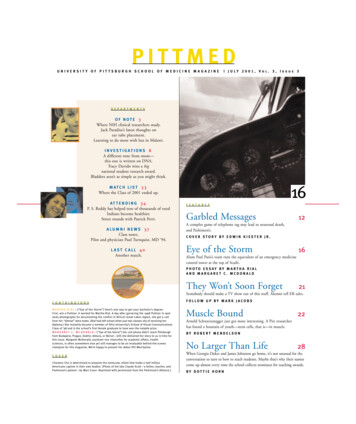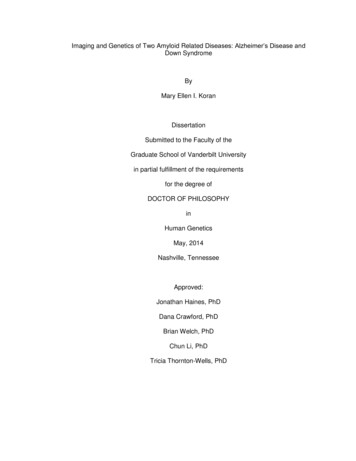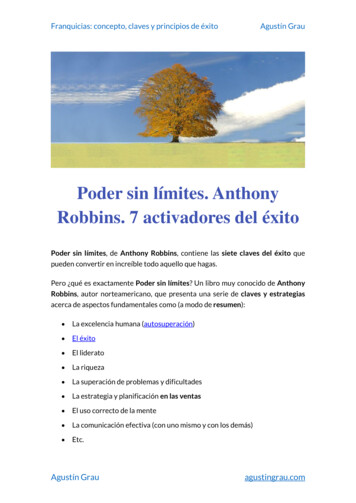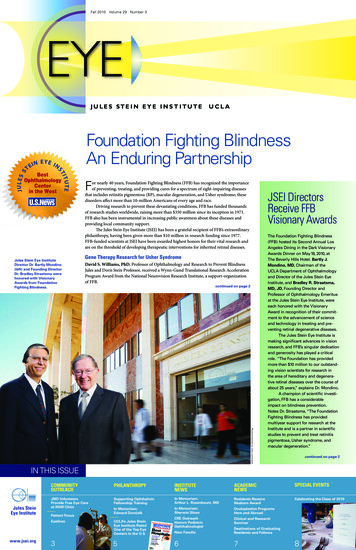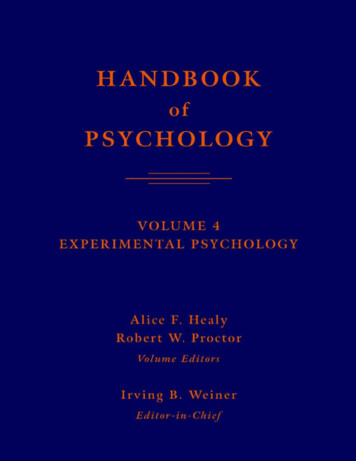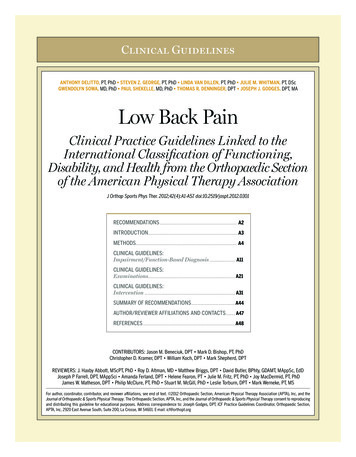
Transcription
Clinical GuidelinesANTHONY DELITTO, PT, PhD STEVEN Z. GEORGE, PT, PhD LINDA VAN DILLEN, PT, PhD JULIE M. WHITMAN, PT, DScGWENDOLYN SOWA, MD, PhD PAUL SHEKELLE, MD, PhD THOMAS R. DENNINGER, DPT JOSEPH J. GODGES, DPT, MALow Back PainClinical Practice Guidelines Linked to theInternational Classification of Functioning,Disability, and Health from the Orthopaedic Sectionof the American Physical Therapy AssociationJ Orthop Sports Phys Ther. 2012;42(4):A1-A57. doi:10.2519/jospt.2012.0301RECOMMENDATIONS. . . . . . . . . . . . . . . . . . . . . . . . . . . . . . . . . . . . . . . . . . . . . . . . . . . A2INTRODUCTION. . . . . . . . . . . . . . . . . . . . . . . . . . . . . . . . . . . . . . . . . . . . . . . . . . . . . . . . . . . . A3METHODS. . . . . . . . . . . . . . . . . . . . . . . . . . . . . . . . . . . . . . . . . . . . . . . . . . . . . . . . . . . . . . . . . . . A4CLINICAL GUIDELINES:Impairment/Function-Based Diagnosis. . . . . . . . . . . . . . . . . A11CLINICAL GUIDELINES:Examinations. . . . . . . . . . . . . . . . . . . . . . . . . . . . . . . . . . . . . . . . . . . . . . . . . . . . . . . . . . A21CLINICAL GUIDELINES:Intervention. . . . . . . . . . . . . . . . . . . . . . . . . . . . . . . . . . . . . . . . . . . . . . . . . . . . . . . . . . . . . A31SUMMARY OF RECOMMENDATIONS. . . . . . . . . . . . . . . . . . . . . . . . . . . . . A44AUTHOR/REVIEWER AFFILIATIONS AND CONTACTS. . . . . . A47REFERENCES. . . . . . . . . . . . . . . . . . . . . . . . . . . . . . . . . . . . . . . . . . . . . . . . . . . . . . . . . . . . . A48CONTRIBUTORS: Jason M. Beneciuk, DPT Mark D. Bishop, PT, PhDChristopher D. Kramer, DPT William Koch, DPT Mark Shepherd, DPTREVIEWERS: J. Haxby Abbott, MScPT, PhD Roy D. Altman, MD Matthew Briggs, DPT David Butler, BPhty, GDAMT, MAppSc, EdDJoseph P Farrell, DPT, MAppSci Amanda Ferland, DPT Helene Fearon, PT Julie M. Fritz, PT, PhD Joy MacDermid, PT, PhDJames W. Matheson, DPT Philip McClure, PT, PhD Stuart M. McGill, PhD Leslie Torburn, DPT Mark Werneke, PT, MSFor author, coordinator, contributor, and reviewer affiliations, see end of text. 2012 Orthopaedic Section, American Physical Therapy Association (APTA), Inc, and theJournal of Orthopaedic & Sports Physical Therapy. The Orthopaedic Section, APTA, Inc, and the Journal of Orthopaedic & Sports Physical Therapy consent to reproducingand distributing this guideline for educational purposes. Address correspondence to: Joseph Godges, DPT, ICF Practice Guidelines Coordinator, Orthopaedic Section,APTA, Inc, 2920 East Avenue South, Suite 200, La Crosse, WI 54601. E-mail: icf@orthopt.org42-04 Guidelines.indd 13/21/2012 5:07:07 PM
Low Back Pain: Clinical Practice GuidelinesRecommendations*RISK FACTORS: Current literature does not support a defini-tive cause for initial episodes of low back pain. Risk factorsare multifactorial, population specific, and only weaklyassociated with the development of low back pain. (Recommendation based on moderate evidence.)CLINICAL COURSE: The clinical course of low back pain canbe described as acute, subacute, recurrent, or chronic. Giventhe high prevalence of recurrent and chronic low back painand the associated costs, clinicians should place high priority on interventions that prevent (1) recurrences and (2)the transition to chronic low back pain. (Recommendationbased on theoretical/foundational evidence.)DIAGNOSIS/CLASSIFICATION: Low back pain, without symp-toms or signs of serious medical or psychological conditions,associated with clinical findings of (1) mobility impairmentin the thoracic, lumbar, or sacroiliac regions, (2) referred orradiating pain into a lower extremity, and (3) generalizedpain , is useful for classifying a patient with low back paininto the following International Statistical Classification ofDiseases and Related Health Problems (ICD) categories:low back pain, lumbago, lumbosacral segmental/somaticdysfunction, low back strain, spinal instabilities, flatbacksyndrome, lumbago due to displacement of intervertebraldisc, lumbago with sciatica, and the associated InternationalClassification of Functioning, Disability, and Health (ICF)impairment-based category of low back pain (b28013 Painin back, b28018 Pain in body part, specified as pain in buttock, groin, and thigh) and the following, correspondingimpairments of body function: Acute or subacute low back pain with mobility deficits(b7101 Mobility of several joints) Acute, subacute, or chronic low back pain with movementcoordination impairments (b7601 Control of complexvoluntary movements) Acute low back pain with related (referred) lower extremity pain (b28015 Pain in lower limb) Acute, subacute, or chronic low back pain with radiatingpain (b2804 Radiating pain in a segment or region) Acute or subacute low back pain with related cognitive oraffective tendencies (b2703 Sensitivity to a noxious stimulus, b1522 Range of emotion, b1608 Thought functions,specified as the tendency to elaborate physical symptoms for cognitive/ideational reasons, b1528 Emotionalfunctions, specified as the tendency to elaborate physicalsymptoms for emotional/affective reasons)a2 C hronic low back pain with related generalized pain(b2800 Generalized pain, b1520 Appropriateness of emotion, b1602 Content of thought)DIFFERENTIAL DIAGNOSIS: Clinicians should consider diagnos-tic classifications associated with serious medical conditionsor psychosocial factors and initiate referral to the appropriate medical practitioner when (1) the patient’s clinicalfindings are suggestive of serious medical or psychologicalpathology, (2) the reported activity limitations or impairments of body function and structure are not consistentwith those presented in the diagnosis/classification sectionof these guidelines, or (3) the patient’s symptoms are notresolving with interventions aimed at normalization of thepatient’s impairments of body function. (Recommendationbased on strong evidence.)EXAMINATION – OUTCOME MEASURES: Clinicians should usevalidated self-report questionnaires, such as the OswestryDisability Index and the Roland-Morris Disability Questionnaire. These tools are useful for identifying a patient’sbaseline status relative to pain, function, and disability andfor monitoring a change in a patient’s status throughoutthe course of treatment. (Recommendation based on strongevidence.)EXAMINATION – ACTIVITY LIMITATION AND PARTICIPATIONRESTRICTION MEASURES: Clinicians should routinely assessactivity limitation and participation restriction throughvalidated performance-based measures. Changes in thepatient’s level of activity limitation and participation restriction should be monitored with these same measures overthe course of treatment. (Recommendation based on expertopinion.)INTERVENTIONS – MANUAL THERAPY: Clinicians should consid-er utilizing thrust manipulative procedures to reduce painand disability in patients with mobility deficits and acutelow back and back-related buttock or thigh pain. Thrust manipulative and nonthrust mobilization procedures can alsobe used to improve spine and hip mobility and reduce painand disability in patients with subacute and chronic lowback and back-related lower extremity pain. (Recommendation based on strong evidence.)INTERVENTIONS – TRUNK COORDINATION, STRENGTHENING, ANDENDURANCE EXERCISES: Clinicians should consider utilizingtrunk coordination, strengthening, and endurance exercisesto reduce low back pain and disability in patients with sub-april 2012 volume 42 number 4 journal of orthopaedic & sports physical therapy42-04 Guidelines.indd 23/21/2012 5:07:08 PM
Low Back Pain: Clinical Practice GuidelinesRecommendations (continued)*acute and chronic low back pain with movement coordination impairments and in patients post lumbar microdiscectomy. (Recommendation based on strong evidence.)INTERVENTIONS – CENTRALIZATION AND DIRECTIONAL PREFERENCE EXERCISES AND PROCEDURES: Clinicians should considerutilizing repeated movements, exercises, or procedures topromote centralization to reduce symptoms in patients withacute low back pain with related (referred) lower extremitypain. Clinicians should consider using repeated exercises ina specific direction determined by treatment response to improve mobility and reduce symptoms in patients with acute,subacute, or chronic low back pain with mobility deficits.(Recommendation based on strong evidence.)INTERVENTIONS – FLEXION EXERCISES: Clinicians can considerflexion exercises, combined with other interventions such asmanual therapy, strengthening exercises, nerve mobilizationprocedures, and progressive walking, for reducing pain anddisability in older patients with chronic low back pain withradiating pain. (Recommendation based on weak evidence.)INTERVENTIONS – LOWER-QUARTER NERVE MOBILIZATION PROCEDURES: Clinicians should consider utilizing lower-quarternerve mobilization procedures to reduce pain and disabilityin patients with subacute and chronic low back pain andradiating pain. (Recommendation based on weak evidence.)INTERVENTIONS – TRACTION: There is conflicting evidence forthe efficacy of intermittent lumbar traction for patients withlow back pain. There is preliminary evidence that a subgroup of patients with signs of nerve root compression alongwith peripheralization of symptoms or a positive crossedstraight leg raise will benefit from intermittent lumbar traction in the prone position. There is moderate evidence thatclinicians should not utilize intermittent or static lumbartraction for reducing symptoms in patients with acuteor subacute, nonradicular low back pain or patients withchronic low back pain. (Recommendation based on conflicting evidence.)INTERVENTIONS – PATIENT EDUCATION AND COUNSELING:Clinicians should not utilize patient education and counseling strategies that either directly or indirectly increase theperceived threat or fear associated with low back pain, suchas education and counseling strategies that (1) promoteextended bed-rest or (2) provide in-depth, pathoanatomical explanations for the specific cause of the patient’s lowback pain. Patient education and counseling strategies forpatients with low back pain should emphasize (1) the promotion of the understanding of the anatomical/structuralstrength inherent in the human spine, (2) the neuroscience that explains pain perception, (3) the overall favorableprognosis of low back pain, (4) the use of active pain copingstrategies that decrease fear and catastrophizing, (5) theearly resumption of normal or vocational activities, evenwhen still experiencing pain, and (6) the importance ofimprovement in activity levels, not just pain relief. (Recommendation based on moderate evidence.)INTERVENTIONS – PROGRESSIVE ENDURANCE EXERCISE AND FITNESS ACTIVITIES: Clinicians should consider (1) moderate- tohigh-intensity exercise for patients with chronic low backpain without generalized pain, and (2) incorporating progressive, low-intensity, submaximal fitness and enduranceactivities into the pain management and health promotionstrategies for patients with chronic low back pain with generalized pain. (Recommendation based on strong evidence.)*These recommendations and clinical practice guidelines are based on the scientificliterature accepted for publication prior to January 2011.IntroductionAIM OF THE GUIDELINESThe Orthopaedic Section of the American Physical TherapyAssociation (APTA) has an ongoing effort to create evidencebased practice guidelines for orthopaedic physical therapymanagement of patients with musculoskeletal impairmentsdescribed in the World Health Organization’s InternationalClassification of Functioning, Disability, and Health (ICF). 325The purposes of these clinical guidelines are to: Describe evidence-based physical therapy practice, including diagnosis, prognosis, intervention, and assessment ofoutcome, for musculoskeletal disorders commonly managed by orthopaedic physical therapists Classify and define common musculoskeletal conditions using the World Health Organization’s terminology related tojournal of orthopaedic & sports physical therapy volume 42 number 4 april 2012 42-04 Guidelines.indd 3a33/21/2012 5:07:08 PM
Low Back Pain: Clinical Practice GuidelinesIntroduction (continued) impairments of body function and body structure, activitylimitations, and participation restrictions Identify interventions supported by current best evidenceto address impairments of body function and structure, activity limitations, and participation restrictions associatedwith common musculoskeletal conditions Identify appropriate outcome measures to assess changesresulting from physical therapy interventions in body function and structure as well as in activity and participation ofthe individual Provide a description to policy makers, using internationally accepted terminology, of the practice of orthopaedicphysical therapists Provide information for payers and claims reviewers regarding the practice of orthopaedic physical therapy forcommon musculoskeletal conditions Create a reference publication for orthopaedic physicaltherapy clinicians, academic instructors, clinical instructors, students, interns, residents, and fellows regarding thebest current practice of orthopaedic physical therapyThe purpose of these low back pain clinical practice guidelines, in particular, is to describe the peer-reviewed literature and make recommendations related to (1) treatmentmatched to low back pain subgroup responder categories,(2) treatments that have evidence to prevent recurrence oflow back pain, and (3) treatments that have evidence to influence the progression from acute to chronic low back painand disability.STATEMENT OF INTENTThese guidelines are not intended to be construed as or toserve as a standard of medical care. Standards of care aredetermined on the basis of all clinical data available for anindividual patient and are subject to change as scientificknowledge and technology advance and patterns of careevolve. These parameters of practice should be consideredguidelines only. Adherence to them will not ensure a successful outcome in every patient, nor should they be construedas including all proper methods of care or excluding otheracceptable methods of care aimed at the same results. Theultimate judgment regarding a particular clinical procedureor treatment plan must be made in light of the clinical datapresented by the patient, the diagnostic and treatment options available, and the patient’s values, expectations, andpreferences. However, we suggest that significant departuresfrom accepted guidelines should be documented in the patient’s medical records at the time the relevant clinical decision is made.MethodsContent experts were appointed by the Orthopaedic Section, APTA as developers and authors of clinical practiceguidelines for musculoskeletal conditions of the low backregion. These content experts were given the task to identifyimpairments of body function and structure, activity limitations, and participation restrictions, described using ICFterminology, that could (1) categorize patients into mutuallyexclusive impairment patterns upon which to base intervention strategies, and (2) serve as measures of changes infunction over the course of an episode of care. The secondtask given to the content experts was to describe the supporting evidence for the identified impairment pattern classification as well as interventions for patients with activitylimitations and impairments of body function and structureconsistent with the identified impairment pattern classification. It was also acknowledged by the Orthopaedic Section,APTA content experts that only performing a systematicsearch and review of the evidence related to diagnostic categories based on International Statistical Classification ofa4 Diseases and Related Health Problems (ICD) terminologywould not be sufficient for these ICF-based clinical practiceguidelines, as most of the evidence associated with changesin levels of impairment or function in homogeneous populations is not readily searchable using the ICD terminology. Thus, the authors of these guidelines independentlyperformed a systematic search of the MEDLINE, CINAHL,and the Cochrane Database of Systematic Reviews (1966through 2010) for any relevant articles related to classification, examination, and intervention for musculoskeletalconditions related to the low back region. The lead author(A.D.) assigned a specific subcategory (classification, measures, and intervention strategies for musculoskeletal conditions of the low back region) to search based upon theirspecific area of expertise. Two authors were assigned toeach subcategory and both individuals performed a separate search, including but not limited to the 3 databaseslisted above, to identify articles to ensure that no studies ofrelevance were omitted. Additionally, when relevant articlesapril 2012 volume 42 number 4 journal of orthopaedic & sports physical therapy42-04 Guidelines.indd 43/21/2012 5:07:09 PM
Low Back Pain: Clinical Practice GuidelinesMethods (continued)were identified, their reference lists were hand-searched inan attempt to identify other articles that might have contributed to the content of these clinical practice guidelines.Articles from the searches were compiled and reviewed foraccuracy by the authors. Articles with the highest levels ofevidence that were most relevant to classification, examination, and intervention for patients with musculoskeletalconditions related to the low back region were included inthese guidelines.These guidelines were issued in 2012 based upon articlesaccepted for publication in the scientific literature prior toJanuary 2011. These guidelines will be considered for review in 2017, or sooner if new evidence becomes available.Any updates to the guidelines in the interim period will benoted on the Orthopaedic Section of the APTA website:www.orthopt.org.GRADES OF RECOMMENDATIONBASED ONStrong evidenceA preponderance of level I and/or level II studies support the recommendation. This must includeat least 1 level I studyModerate evidenceA single high-quality randomizedcontrolled trial or a preponderance of level II studies supportthe recommendationWeak evidenceA single level II study or a preponderance of level III and IV studies,including statements of consensus by content experts, supportthe recommendationConflicting evidenceHigher-quality studies conducted on this topic disagree withrespect to their conclusions. Therecommendation is based onthese conflicting studiesTheoretical/foundationalevidenceA preponderance of evidencefrom animal or cadaver studies,from conceptual models/principles, or from basic science/bench research supports thisconclusionExpert opinionBest practice based on the clinical experience of the guidelinedevelopment teamABCDLEVELS OF EVIDENCEIndividual clinical research articles were graded accordingto criteria described by the Centre for Evidence-Based Medicine, Oxford, United Kingdom (http://www.cebm.net/index.aspx?o 1025) for diagnostic, prospective, and therapeuticstudies.238 If the 2 content experts did not agree on a gradeof evidence for a particular article, a third content expert wasused to resolve the issue.IEvidence obtained from high-quality diagnostic studies,prospective studies, or randomized controlled trialsIIEvidence obtained from lesser-quality diagnostic studies,prospective studies, or randomized controlled trials(eg, weaker diagnostic criteria and reference standards,improper randomization, no blinding, 80% follow-up)IIICase-controlled studies or retrospective studiesIVCase seriesVExpert opinionGRADES OF EVIDENCEThe overall strength of the evidence supporting recommendations made in these guidelines will be graded according toguidelines described by Guyatt et al,132 as modified by MacDermid and adopted by the coordinator and reviewers of thisproject. In this modified system, the typical A, B, C, and Dgrades of evidence have been modified to include the role ofconsensus expert opinion and basic science research to demonstrate biological or biomechanical plausibility.ESTRENGTH OF EVIDENCEFREVIEW PROCESSThe Orthopaedic Section, APTA also selected consultantsfrom the following areas to serve as reviewers of the earlydrafts of these clinical practice guidelines: Claims review Coding Epidemiology Low back pain rehabilitation Manipulative therapy Medical practice guidelines Movement science Orthopaedic physical therapy residency education Outcomes research Pain sciences Physical therapy academic education Rheumatologyjournal of orthopaedic & sports physical therapy volume 42 number 4 april 2012 42-04 Guidelines.indd 5a53/21/2012 5:07:10 PM
Low Back Pain: Clinical Practice GuidelinesMethods (continued) S pinal biomechanics Sports physical therapy residency education Sports rehabilitationComments from these reviewers were utilized by the authorsto edit these clinical practice guidelines prior to submittingthem for publication to the Journal of Orthopaedic & SportsPhysical Therapy. In addition, several physical therapistspracticing in orthopaedic and sports physical therapy settings were sent initial drafts of this clinical practice guidelinealong with feedback forms to assess its usefulness, validity,and impact.Several practicing clinicians and reviewers noted that theclassification criteria summary of the ICF-based Neck PainClinical Practice Guidelines49 was useful in linking data gathered during the patient’s subjective and physical examinationsto diagnostic classification and intervention. Thus, similarrecommended classification criteria were included by theauthors for these ICF-based Low Back Pain Clinical PracticeGuidelines, which provide a summary of symptoms, impairment findings, and matched interventions for each diagnostic category. This summary is provided in the RecommendedLow Back Pain Impairment/Function-based ClassificationCriteria with Recommended Interventions table.CLASSIFICATIONThe primary ICD-10 codes and conditions associated withlow back pain are: M99.0 Lumbosacral segmental/somatic dysfunction, M53.2 Spinal instabilities, M40.3 Flatback syndrome,M51.2 Lumbago due to displacement of intervertebral disc, M54.1Lumbar radiculopathy, M54.4 Lumbago with sciatica, M54.5 Lowback pain, G96.8 Disorder of central nervous system, specified ascentral nervous system sensitivity to pain, and F45.4 Persistent somatoform pain disorder.324 The corresponding ICD-9-CM codesand conditions, which are used in the United States, are 739.3Nonallopathic lesion, lumbar region, 846.0 Lumbosacral ligamentsprain, 724.3 Sciatica, 724.4 Thoracic or lumbosacral neuritis or radiculitis, unspecified, and 724.2 Lumbago.a6 The primary ICF body-function codes associated with theabove noted ICD-10 conditions are b28013 Pain in back,b28018 Pain in body part, specified as pain in buttock, groin, andthigh, b28015 Pain in lower limb, b2803 Radiating pain in a dermatome, b2703 Sensitivity to a noxious stimulus, b2800 Generalized pain, b7101 Mobility of several joints, b7108 Mobility of jointfunctions, specified as mobility in a vertebral segment, b7601Control of complex voluntary movements, b789 Movement functions, specified as mobility of the meninges, peripheral nerves andadjacent tissues, b1520 Appropriateness of emotion, b1522 Rangeof emotion, b1528 Emotional functions, specified as the tendencyto elaborate physical symptoms for emotional/affective reasons,b1602 Content of thought, and b1608 Thought functions, specified as the tendency to elaborate physical symptoms for cognitive/ideational reasons.The primary ICF body-structure codes associated with lowback pain are s76001 Thoracic vertebral column, s76002 Lumbarvertebral column, s7602 Ligaments and fasciae of trunk, s130 Structure of meninges, s1201 Spinal nerves, s7601 Muscles of trunk, s7401Joints of pelvic region, s7402 Muscles of pelvic region, s75001 Hipjoint, s75002 Muscles of thigh, s1100 Structure of cortical lobes,s1101 Structure of midbrain, s1102 Structure of diencephalon, s1103Basal ganglia and related structures, s1104 Structure of brainstem,and s1200 Structure of spinal cord.The primary ICF activities and participation codes associated with low back pain are d4108 Bending, d4106 Shifting thebody’s centre of gravity, d4158 Maintaining a body position, d4153Maintaining a sitting position, d2303 Completing the daily routine,d5701 Managing diet and fitness, and d129 Purposeful sensory experiences, specified as repetitive perception of noninjurious sensorystimuli.The ICD-10 and ICF codes associated with low back pain areprovided in the following table.april 2012 volume 42 number 4 journal of orthopaedic & sports physical therapy42-04 Guidelines.indd 63/21/2012 5:07:11 PM
Low Back Pain: Clinical Practice GuidelinesICD-10 and ICF Codes Associated With Low Back PainINTERNATIONAL STATISTICAL CLASSIFICATION OF DISEASES AND RELATED HEALTH PROBLEMS (ICD) CODESAcute and Subacute Low Back Pain with MobilityM99.0Lumbosacral segmental/somatic dysfunctionM53.2Spinal instabilitiesM40.3Flatback syndromeM51.2Other specified intervertebral disc displacement (lumbago due to displacementM54.1Lumbar radiculopathy (neuritis or radiculitis)M54.4Lumbago with sciaticaM54.5Low back painG96.8Disorder of central nervous system, specified as central nervous system sensitivityM54.5Low back painG96.8Disorder of central nervous system, specified as central nervous system sensitivityF45.4Persistent somatoform pain disorderDeficitsAcute, Subacute, and Chronic Low Back Pain withMovement Coordination ImpairmentsAcute Low Back Pain with Related (Referred) LowerExtremity Painof intervertebral disc)Acute, Subacute, and Chronic Low Back Pain withRadiating PainAcute or Subacute Low Back Pain with RelatedCognitive or Affective Tendenciesto painChronic Low Back Pain with Related Generalized Painto painINTERNATIONAL CLASSIFICATION OF FUNCTIONING, DISABILITY, AND HEALTH (ICF) CODESACUTE LOW BACK PAIN WITH MOBILITY DEFICITSBody functionsBody structureActivities and participationb28013Pain in backb28018Pain in body part, specified as pain in buttock, groin, and thighb7101Mobility of several jointsb7108Mobility of joint functions, specified as mobility in a vertebral segments76001Thoracic vertebral columns76002Lumbar vertebral columns7401Joints of pelvic regiond4108BendingSUBACUTE LOW BACK PAIN WITH MOBILITY DEFICITSBody functionsBody structureb28013Pain in backb28018Pain in body part, specified as pain in buttock, groin, and thighb7101Mobility of several jointsb7108Mobility of joint functions, specified as mobility in a vertebral segments76001Thoracic vertebral columns76002Lumbar vertebral columns7401Joints of pelvic regions7402Muscles of pelvic regions75001Hip joints75002Muscles of thighjournal of orthopaedic & sports physical therapy volume 42 number 4 april 2012 42-04 Guidelines.indd 7a73/21/2012 5:07:11 PM
Low Back Pain: Clinical Practice GuidelinesBody structure (continued)s75003Ligaments and fascia of thighActivities and participationd4108BendingACUTE LOW BACK PAIN WITH MOVEMENT COORDINATION IMPAIRMENTSBody functionsBody structureActivities and participationb28013Pain in backb28015Pain in lower limbb7601Control of complex voluntary movementss7601Muscles of trunks7602Ligaments and fasciae of trunks7402Muscles of pelvic regiond4106Shifting the body’s centre of gravityd4158Maintaining a body position, specified as maintaining alignment of the trunk, pelvis andlower extremities such that the lumbar vertebral segments function in a neutral, ormid-range, positionSUBACUTE AND CHRONIC LOW BACK PAIN WITH MOVEMENT COORDINATION IMPAIRMENTSBody functionsBody structureActivities and participationb28013Pain in backb28015Pain in lower limbb7601Control of complex voluntary movementss7601Muscles of trunks7602Ligaments and fasciae of trunks7402Muscles of pelvic regions75001Hip joints75002Muscles of thighs75003Ligaments and fascia of thighd4106Shifting the body’s centre of gravityd4158Maintaining a body position, specified as maintaining alignment of the trunk, pelvis andlower extremities such that the lumbar vertebral segments function in a neutral, ormid-range, positiond4153Maintaining a sitting positiond4108Bendingd4302Carrying in the armd4303Carrying on shoulders, hip and backd5701Managing diet and fitnessd2303Completing the daily routined6402Cleaning living aread6601Assisting others in movementd9202Arts and culturee1151Assistive products and technology for personal use in daily livinge1351Assistive products and technology for employmente1401Assistive products and technology for culture, recreation, and sportACUTE LOW BACK PAIN WITH RELATED (REFERRED) LOWER EXTREMITY PAINBody functionsa8b28013Pain in backb28015Pain in lower limbb7101Mobility of several jointsBody structures76002Lumbar vertebral columnActivities and participationd4153Maintaining a sitting position april 2012 volume 42 number 4 journal of orthopaedic & sports physical therapy42-04 Guidelines.indd 83/21/2012 5:07:12 PM
Low Back Pain: Clinical Practice GuidelinesActivities and participation (continued)d4158Maintaining a body position, specified as maintaining the lumbar spine in an extended,or neutral position, such as when getting in and out of a sitting or standing position, orwhen lifting, carrying, or putting down objectsACUTE LOW BACK PAIN WITH RADIATING PAINBody functionsb28013Pain in backb2803Radiating pain in a dermatomeb789Movement functions, specified as mobility of the meninges, peripheral nerves and adjacents1201Spinal nervess130Structure of meningesd4108Bendingd4150Maintaining a lying positiond4154Maintaining a standing positiontissuesBody structureActivities and participationSUBACUTE AND CHRONIC LOW BACK PAIN WITH RADIATING PAINBody functionsb28013Pain in backb2803Radiating pain in a dermatomeb789Movement functions, specified as mobility of the meninges, per
Acute, subacute, or chronic low back pain with movement coordination impairments (b7601 Control of complex voluntary movements) Acute low back pain with related (referred) lower extrem-ity pain (b28015 Pain in lower limb) Acute, subacute, or chronic low back pain with radiating pain (b2804 Radiating pain in a segment or region)
